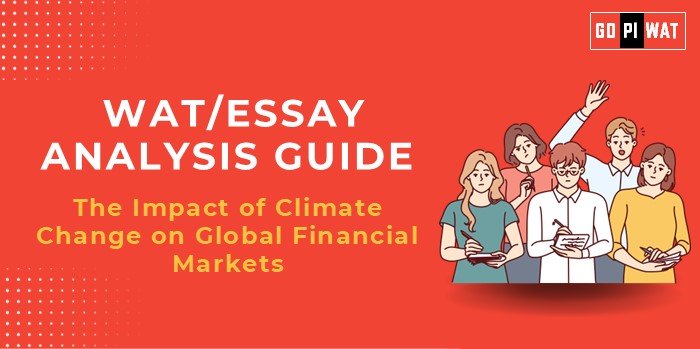📋 WAT/Essay Analysis Guide
🌍 The Impact of Climate Change on Global Financial Markets
🌟 Understanding the Topic’s Importance
Climate change reshapes the global economy, making it a crucial topic for B-school aspirants aiming to address sustainability and economic resilience. Its effects on financial markets provide a lens to analyze systemic risks and innovation opportunities.
📝 Effective Planning and Writing
- Time Allocation:
- Planning: 5 minutes
- Writing: 20 minutes
- Review: 5 minutes
- Structure:
- Introduction: 70 words
- Body: 350 words
- Conclusion: 80 words
💡 Introduction Techniques for Essays
- Contrast Approach: “Despite achieving a $1 trillion green bond milestone, financial markets face $280 billion annual climate losses, revealing the urgency for sustainable adaptation.”
- Solution-Oriented Approach: “Integrating climate risks into financial decisions could transform vulnerabilities into economic opportunities.”
📚 Structuring the Essay Body
- Achievements: Highlight initiatives like green bonds, ESG growth, and global regulations addressing climate risks.
- Challenges: Discuss issues such as data gaps, transition risks, and inconsistent global policies.
- Future Outlook: Explore the potential of standardized frameworks, AI-driven ESG metrics, and resilient financial strategies to address climate risks.
📜 Concluding Effectively
- Balanced Conclusion: “While global markets adapt to climate risks, aligning policies and data standards is essential for sustainable progress.”
- Forward-Looking Conclusion: “The financial sector holds the potential to lead climate adaptation by embedding resilience into economic strategies.”
✍️ Sample Short Essays
- Balanced Perspective: “Climate change impacts financial stability, but markets’ adaptability through ESG adoption shows promise.”
- Solution-Oriented: “Standardized ESG metrics and robust policies are vital to mitigate climate risks and stabilize financial markets.”
- Global Comparison: “While the EU leads in climate finance, bridging regulatory gaps remains a global challenge for market stability.”


